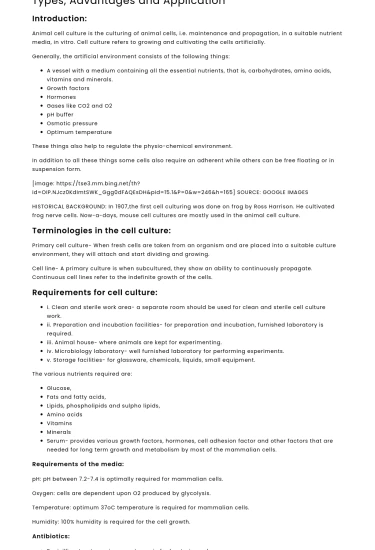Introduction:
Animal cell culture is the culturing of animal cells, i.e. maintenance and propagation, in a suitable nutrient media, in vitro. Cell culture refers to growing and cultivating the cells artificially.
Generally, the artificial environment consists of the following things:
Save your time!
We can take care of your essay
- Proper editing and formatting
- Free revision, title page, and bibliography
- Flexible prices and money-back guarantee
- A vessel with a medium containing all the essential nutrients, that is, carbohydrates, amino acids, vitamins and minerals.
- Growth factors
- Hormones
- Gases like CO2 and O2
- pH buffer
- Osmotic pressure
- Optimum temperature
These things also help to regulate the physio-chemical environment.
In addition to all these things some cells also require an adherent while others can be free floating or in suspension form.
[image: https://tse3.mm.bing.net/th?id=OIP.NJcz0KdImtSWK_Ggg0dFAQEsDH&pid=15.1&P=0&w=246&h=165] SOURCE: GOOGLE IMAGES
HISTORICAL BACKGROUND: In 1907,the first cell culturing was done on frog by Ross Harrison. He cultivated frog nerve cells. Now-a-days, mouse cell cultures are mostly used in the animal cell culture.
Terminologies in the cell culture:
Primary cell culture- When fresh cells are taken from an organism and are placed into a suitable culture environment, they will attach and start dividing and growing.
Cell line- A primary culture is when subcultured, they show an ability to continuously propagate. Continuous cell lines refer to the indefinite growth of the cells.
Requirements for cell culture:
- i. Clean and sterile work area- a separate room should be used for clean and sterile cell culture work.
- ii. Preparation and incubation facilities- for preparation and incubation, furnished laboratory is required.
- iii. Animal house- where animals are kept for experimenting.
- iv. Microbiology laboratory- well furnished laboratory for performing experiments.
- v. Storage facilities- for glassware, chemicals, liquids, small equipment.
The various nutrients required are:
- Glucose,
- Fats and fatty acids,
- Lipids, phospholipids and sulpho lipids,
- Amino acids
- Vitamins
- Minerals
- Serum- provides various growth factors, hormones, cell adhesion factor and other factors that are needed for long term growth and metabolism by most of the mammalian cells.
Requirements of the media:
pH: pH between 7.2-7.4 is optimally required for mammalian cells.
Oxygen: cells are dependent upon O2 produced by glycolysis.
Temperature: optimum 37oC temperature is required for mammalian cells.
Humidity: 100% humidity is required for the cell growth.
Antibiotics:
- Penicillin, streptomycin or gentamycin for bacteria, and
- Nystatin for fungi and yeast.
Types of Animal Cell Culture:
- · Primary culture: Fresh cells are taken from an organism and are placed into a suitable culture environment. The cells get attach, divide and grow in that environment. There are two methods for preparing primary cell culture.
- (a) In a plastic culture vessel, small pieces of tissue are treated and then bathed in a culture medium. This method is used for Explant cultures. In a few days, cells from the tissue explant move onto the culture vessel surface and then it will divide and grow there.
- (b) This method uses a digesting proteolytic enzyme like trypsin, which is added to the pieces of tissue to dissolve the cement holding the cells together and thus speeding up the process. This creates the suspension of single cells. These cells are then kept in a culture vessel and they divide and grow there. This method is known as Enzymatic Dissociation.
- · Secondary cell culture: After the cells are grown in primary cell culture, they are sub-cultured to give them room for continued growth.
For doing this, they are gently removed from substrate with enzymes. After the cells are released, they can further subdivided and placed into new culture vessel. Then the cells are treated with suitable cryoprotective agents like glycerol. After that, they are frozen and stored at -130o C till they are needed.
Advantages of Animal Cell Culture:
- a. We can get Controlled physiological and physiochemical environment like pH, temperature, etc.
- b. Homogeneity of cell types
- c. It is comparatively an economical process.
Applications of Animal Cell Culture:
- (a) Model Systems: Cell culture is used for studying basic cell biology and biochemistry, interactions between disease causing agents and cells, effects of drugs on cells, etc.
- (b) Toxicity Testing: Cell culture is also used to study the effects of drugs, cosmetics and chemicals.
- (c) Cancer Research: Cell culture is also used to study the difference between normal cells and cancer cells. Cultured cancer cells are also used to determine suitable drugs and methods to cure cancer.
- (d) Virology: Replication of viruses in the cell cultures is one of the earliest uses of cell culture used in vaccine production.
- (e) Gene Therapy:In gene therapy, cloned genes are inserted into cells using r-DNA technology. In this way, defective genes can be replaced that cause genetic abnormalities.






 Stuck on your essay?
Stuck on your essay?

